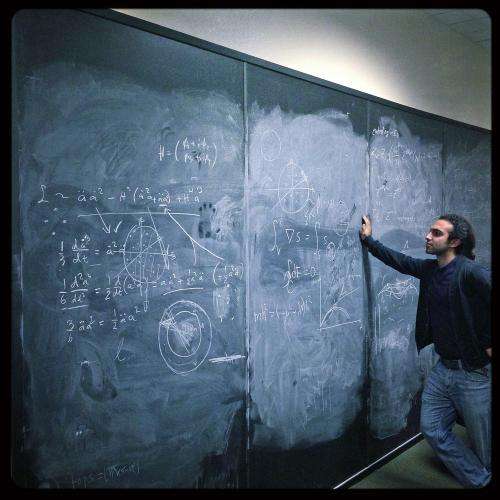New groundbreaking research may expose new aspects of the universe

No one knows for sure, but it is not unlikely that the universe is constructed in a completely different way than the usual theories and models of today predict. The most widely used model today cannot explain everything in the universe, and therefore there is a need to explore the parts of nature which the model cannot explain. This research field is called new physics, and it turns our understanding of the universe upside down. New research now makes the search for new physics easier.
"New physics is about searching for unknown physical phenomena not known from the current perception of the universe. Such phenomena are inherently very difficult to detect," explains PhD student Matin Mojaza from CP3-Origins.
Together with colleagues Stanley J. Brodsky from Stanford University in the U.S. and Xing-Gang Wu from Chongqing University in China, Mojaza has now succeeding in creating a new method that can make it easier to search for new physics in the universe. The method is a so called scalesetting procedure, and it fills out some empty, but very important, holes in the theories, models and simulations, which form the basis for all particle physics today.
"With this method we can eliminate much of the uncertainty in theories and models of today," says Matin Mojaza.
Many theories and models in particle physics today has the problem that they, together with their predictions, provide some parameters that scientists do not know how to set.
"Physicists do not know what values they should give these parameters. For example, when we study the Standard Model and see these unknown parameters, we cannot know whether they should be interpreted as conditions that support or oppose to the Standard Model – this makes it quite difficult to study the Standard Model accurately enough to investigate its value", explains Matin Mojaza.
With the new approach researchers can now completely clean their models for the unknown parameters and thus become better at assessing whether a theory or a model holds water.
The standard model has for the last app. 50 years been the prevailing theory of how the universe is constructed. According to this theory, 16 (17 if we include the Higgs particle) subatomic particles form the basis for everything in the universe. But the Standard Model is starting to fall short, so it is now necessary to look for new physics in the universe. One of the Standard Model's major problems is that it cannot explain gravity, and another is that it cannot explain the existence of dark matter, believed to make up app. 25 percent of all matter in the universe. In addition, the properties of the newly discovered Higgs particle, as described in the standard model, is incompatible with a stable universe.
"A part of the Standard Model is the theory of quantum chromodynamics, and this is one of the first things, we want to review with our new method, so that we can clean it from the uncertainties," explains Matin Mojaza.
The theory of quantum chromodynamics predicts how quarks (such as protons and neutrons) and gluons (particles that keeps quarks in place inside the protons and neutrons) interact.
Matin and his Chinese and American colleagues now estimate that there may be a basis for reviewing many scientific calculations to clean the results from uncertainties and thus obtain a more reliable picture of whether the results support or contradict current models and theories.
"Maybe we find new indications of new physics, which we would not have exposed if we had not had this new method", says Matin Mojaza.
He believes that the Standard Model needs to be extended so that it can explain the Higgs particle, dark matter and gravity. One possibility in this regard is to examine the so-called technicolor theory, and another is the theory of supersymmetry. According to the supersymmetry theory, each particle has a partner somewhere in the universe - these have not yet been found though. According to the technicolor theory there is a special techni-force that binds so-called techni-quarks, which can form other particles - perhaps this is how the Higgs particle is formed. This could explain the problems with the current model of the Higgs particle.
Also Rolf-Dieter Heuer, director of CERN in Switzerland, where the famous 27 km long particle accelerator, the LHC, is situated, believes that the search for new physics is important. According to him, the Standard Model cannot be the ultimate theory, and it is only capable of describing about 35 percent of the universe. Like CP3-Origins, also CERN has put focus on weeding out old theories and search for new physics – this happening in 2015, when the accelerator starts up again.
CP3-Origins is a center at University of Southern Denmark, researching in the physics beyond the Standard Model. The center focuses on topics such as dark matter, the formation of matter in the universe, and the mystery of what the Higgs particle might consist of.
More information:
A Systematic All-Orders Method to Eliminate Renormalization-Scale and Scheme Ambiguities in PQCD, Physical Review Letters, vol 110, issue 19. Authors: Matin Mojaza, Stanley J. Brodsky, Xing-Gang Wu.
arxiv.org/abs/1304.4631
Journal information: Physical Review Letters
Provided by University of Southern Denmark


















